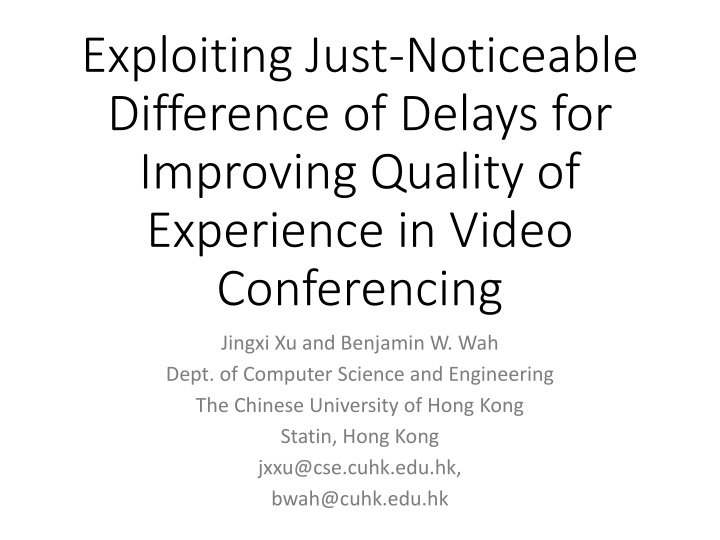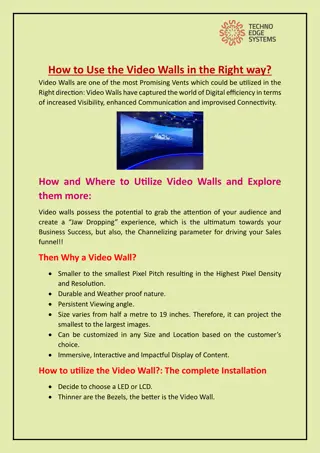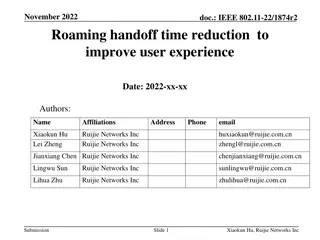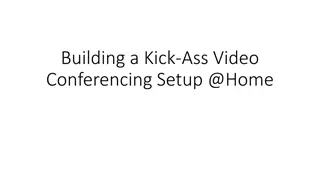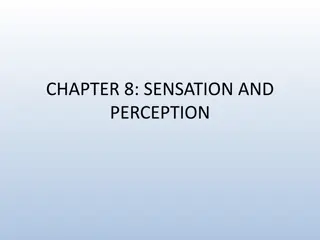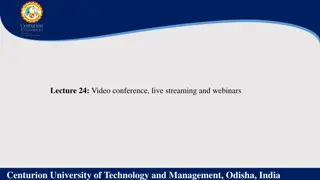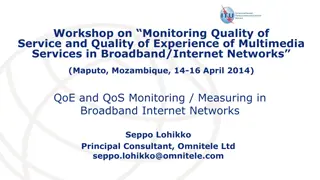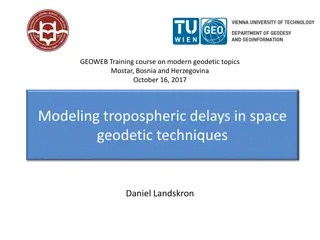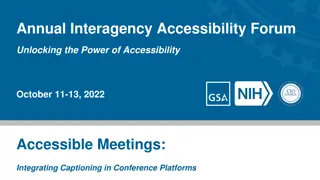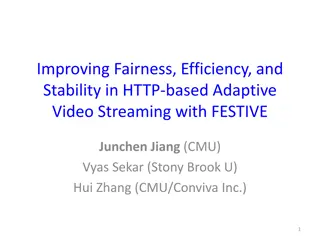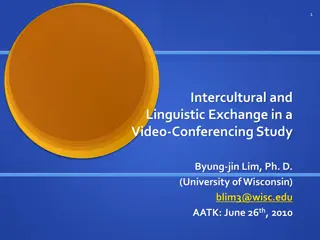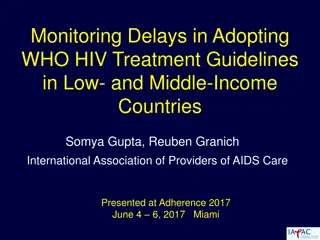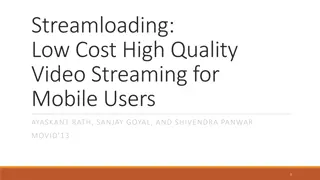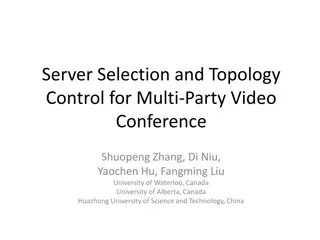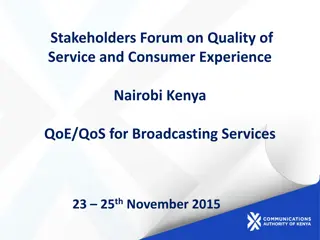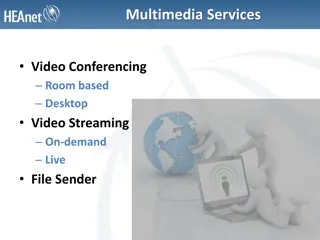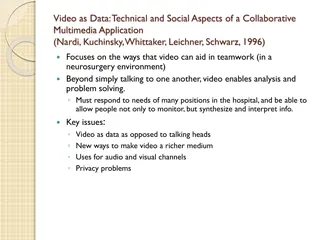Enhancing Video Conferencing QoE Using Just-Noticeable Difference of Delays
This research explores leveraging the Just-Noticeable Difference (JND) of delays to enhance the Quality of Experience (QoE) in video conferencing systems. By studying network and conversational conditions, the authors propose improvements to existing systems to achieve better signal quality and interactivity. Emphasis is placed on finding the optimal trade-offs between signal quality and interactivity to improve overall QoE effectively.
Download Presentation

Please find below an Image/Link to download the presentation.
The content on the website is provided AS IS for your information and personal use only. It may not be sold, licensed, or shared on other websites without obtaining consent from the author.If you encounter any issues during the download, it is possible that the publisher has removed the file from their server.
You are allowed to download the files provided on this website for personal or commercial use, subject to the condition that they are used lawfully. All files are the property of their respective owners.
The content on the website is provided AS IS for your information and personal use only. It may not be sold, licensed, or shared on other websites without obtaining consent from the author.
E N D
Presentation Transcript
Exploiting Just-Noticeable Difference of Delays for Improving Quality of Experience in Video Conferencing Jingxi Xu and Benjamin W. Wah Dept. of Computer Science and Engineering The Chinese University of Hong Kong Statin, Hong Kong jxxu@cse.cuhk.edu.hk, bwah@cuhk.edu.hk
Introduction The quality of a video conferencing system is often measured by its quality of experience (QoE) network loss rate, traffic jitter, link delay, conversational condition, and loss concealment mechanisms in the codec To achieve good QoE in a video conferencing system under given network and conversational conditions Compare in a relative sense the perceptual quality of two operating points and to identify whether one is better than or indistinguishable from another Entails tradeoffs among the objective metrics
Introduction(cont.) In comparing operating points of existing systems, Some overly emphasize interactivity without sufficient attention to signal quality the MED(mouth-to-ear delay) is not sufficient to cover the network delay as well as the buffering time to smooth delay jitters and to recover lost packets Without proper trade-offs between signal quality and interactivity, the overall QoE will be low Signal quality can be significantly improved if MED is slightly extended Just Noticeable Difference(JND) the maximum MED
Introduction(cont.) Problem statement study the JND in video conferencing under various network and conversational conditions use it to guide the improvement in QoE of the default operating point of existing video-conferencing systems Approach Use JND to help improve QoE in video conferencing under various network Study the current Internet conditions from a large set of network traces and investigate when the increase in MED can help mitigate network losses and jitters
Introduction(cont.) Contributions A study of network conditions in the Internet with respect to buffering delays and packet sending rates The properties of JND in video conferencing under various network and conversational conditions The improvement of existing proprietary video conferencing systems, without knowing their operating parameters.
Problem Illustration Video Quality Metric (VQM) One-way video quality Higher correlation to the subjective mean opinion score(MOS) than traditional signal quality metrics(ex.PSNR) [0.0, 1.0] (the smaller the better) Perceptual Evaluation of Speech Quality (PESQ) One-way audio quality High correlation to perceptual MOS [ 0.5, 4.5] (the larger the better)
Problem Illustration(cont.) Interactivity is an important quality metric in video conferencing MED, conversational symmetry (CS), conversational efficiency (CE)
Traffic Measurements in the PlanetLab Randomly select a pair of nodes from a set of 180 nodes and collected a set of traces from 46 different links Collected 1-minute network traces with sending bit rates ranging from 100 kbps to 1000 kbps
Traffic Measurements in the PlanetLab(cont.) K-Means algorithm Manually merge the clusters into 4 classes of network conditions according to their loss rate, delay, jitter and whether there is significant congestion when bit rate is increased
Traffic Measurements in the PlanetLab(cont.) Loss rate, delay and jitter Monotonically non-decreasing with increasing sending rate(hypothesis test) A large proportion of links where reducing the traffic rate does not affect the average loss rate and jitters
Concealing Impairments by Buffering Define UPR in the receiver as the ratio of unavailable packets within the MED Packets arriving later than the prescribed MED packets that cannot be recovered after performing FEC using those packets received in time
Concealing Impairments by Buffering(cont.)
Concealing Impairments by Buffering(cont.)
Concealing Impairments by Buffering(cont.) Increasing MED Reduce UPR and provides significant improvements even with a small increase Will not change the network behavior and is applicable under any network condition Rate control help reduce UPR under certain conditions In non-congested links, the average loss rate and delay jitter do not change much when the sending rate is reduced not help improve congestion
Concealing Impairments by Buffering(cont.) Propose to increase MED as the method for reducing UPR in existing video conferencing systems Increase MED in such a way that human cannot perceive the difference in interactivities Signal quality will either be improved or remains the same the overall QoE will be improved or remains the same
Concealing Impairments by Buffering(cont.)
Comparative Subjective Tests A two-way video conference session A is presented to a test subject, who is asked to compare to B(with a different MED)
Comparative Subjective Tests(cont.) Assuming the MED in A is fixed, we increase the MED in B and ask the test subject to determine which of the two sessions has a longer MED JND is the difference between the MED in A and the MED in B Finding the JND of an existing system and use it to extend the system s MED to within JND in order to conceal its losses, while not incurring significant perceptual difference in interactivities
Comparative Subjective Tests(cont.) Following Sat and Wah s definition on JND [32], let p0be the fraction of subjects who correctly identify which of the two sessions has a longer MED Definition 1: The 75% JND of MEDAis the maximum |MEDB MEDA| where p0 0.75 Definition 2: A is perceptually the same as B (MEDB MEDA) if MEDBis within the 75% JND region of MEDA
Comparative Subjective Tests(cont.) Axiom 1. Reflectivity: The MED of any session is within its own JND region, since both are perceptually the same. This allows us to omit the comparison of a session with itself. Axiom 2. Symmetry: is symmetric, since |MEDB MEDA| = |MEDB MEDA|. This allows the sessions to be presented in any order. Axiom 3. IID: The subjects have the same level of expertise, and their ability to discover the difference in MED is independent and identically distributed (IID). This allows us to get the statistics of responses by repeated tests using multiple subjects
Comparative Subjective Tests(cont.) Corollary 1. Non-transitivity: is not transitive. That is, A B and B C does not imply A C. Hence, it will be necessary to carry out all pairwise comparisons with respect to A in order to determine the JND of A similar to Constant stimuli
Experimental Results Increase MEDs every 34 ms in the [0, 136] ms interval on top of the original MEDs of 102 ms, 238 ms and 374 ms Invited eight subjects to participate, and the entire set of tests took about 40 minutes for every subject A test session with a longer MED Play the last few frames back and forth in real time (video) Insert silence during this period (audio)
Experimental Results(cont.) To answer the following questions Does JND change as MED is increased? Does JND change under losses and delay jitters? Does JND change with the type of conversation?
Experimental Results(cont.) JND under lossless networks
Experimental Results(cont.) JND in lossy and jittery networks 31ms average delay jitters 4.3% random losses
Experimental Results(cont.) JND under a conversational scenario with a slow turn frequency
Experimental Results(cont.) JND is reasonably large under various network and conversational conditions By increasing MED to within JND, we can implement additional loss concealments for recovering lost or delayed packets, without affecting the interactivity of a conversation
Design of a Packet Interceptor Skype and MSN Developed a kernel driver using the Windows Filtering Platform
RealTalk: A Testbed for Evaluating QoE in Proprietary Systems Two Windows 7 machines serving as the video conferencing clients The clocks of these machines are synchronized by Net Time Protocol (NTP) An additional Linux machine serving as a network emulator is connected to the two clients, where Trace Control for Netem [24] was installed to emulate different network conditions using the traces collected.
RealTalk: A Testbed for Evaluating QoE in Proprietary Systems(cont.) Developed a virtual camera program with Microsoft DirectShow. Audio is injected by Virtual Audio Cable
Experimental Results Skype Performs poorly under a jittery connection Adds a 100-ms buffer to Skype to smooth its jitters VQM has improved by 33%, and audio quality is decreased slightly by 11%
Experimental Results MSN Performed poorly under lossy conditions Adds a 138-ms buffer to conceal those lost packets using FEC Video quality is improved by 46% and the audio quality is improved by 21%
Conclusions Proposed a novel method for improving existing video conferencing systems by increasing MED Future work Study trade-offs between improvements on signal quality and perceptible degradations on interactivity Study the run-time monitoring of network behaviors, which will allow JND to be determined dynamically in real time
